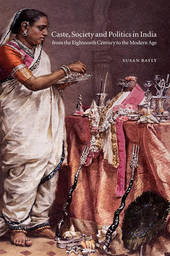
|
Caste, Society and Politics in India from the Eighteenth Century to the Modern Age
Hardback
Main Details
| Title |
Caste, Society and Politics in India from the Eighteenth Century to the Modern Age
|
| Authors and Contributors |
By (author) Susan Bayly
|
| Series | The New Cambridge History of India |
|---|
| Physical Properties |
| Format:Hardback | | Pages:444 | | Dimensions(mm): Height 229,Width 152 |
|
| Category/Genre | Asian and Middle Eastern history
Buddhism
Islam |
|---|
| ISBN/Barcode |
9780521264341
|
| Classifications | Dewey:305.51220954 |
|---|
| Audience | | General | | Professional & Vocational | | Tertiary Education (US: College) | |
|---|
| Illustrations |
3 Maps; 12 Halftones, unspecified
|
|
Publishing Details |
| Publisher |
Cambridge University Press
|
| Imprint |
Cambridge University Press
|
| Publication Date |
15 July 1999 |
| Publication Country |
United Kingdom
|
Description
The phenomenon of caste has probably aroused more controversy than any other aspect of Indian life and thought. Susan Bayly's cogent and sophisticated analysis explores the emergence of the ideas, experiences and practices which gave rise to the so-called 'caste society' from the pre-colonial period to the end of the twentieth century. Using an historical and anthropological approach, she frames her analysis within the context of India's dynamic economic and social order, interpreting caste not as an essence of Indian culture and civilization, but rather as a contingent and variable response to the changes that occurred in the subcontinent's political landscape through the colonial conquest. The idea of caste in relation to Western and Indian 'orientalist' thought is also explored.
Reviews'The book is extraordinary in the diversity of themes that it handles and the chronological span it covers. ... What emerges is an extraordinarily nuanced understanding of caste that satisfies the historian and provokes the social anthropologist.' Dr Seema Alavi, The Book Review 'Susan Bayley deserves praise for attempting to explain how caste in India has come to mean what it does today. Her analysis covers almost the entire Indian subcontinent, something which today is a rarity, given the current trend of ever more narrowly focused studies.' The Journal of Peasant Studies
|